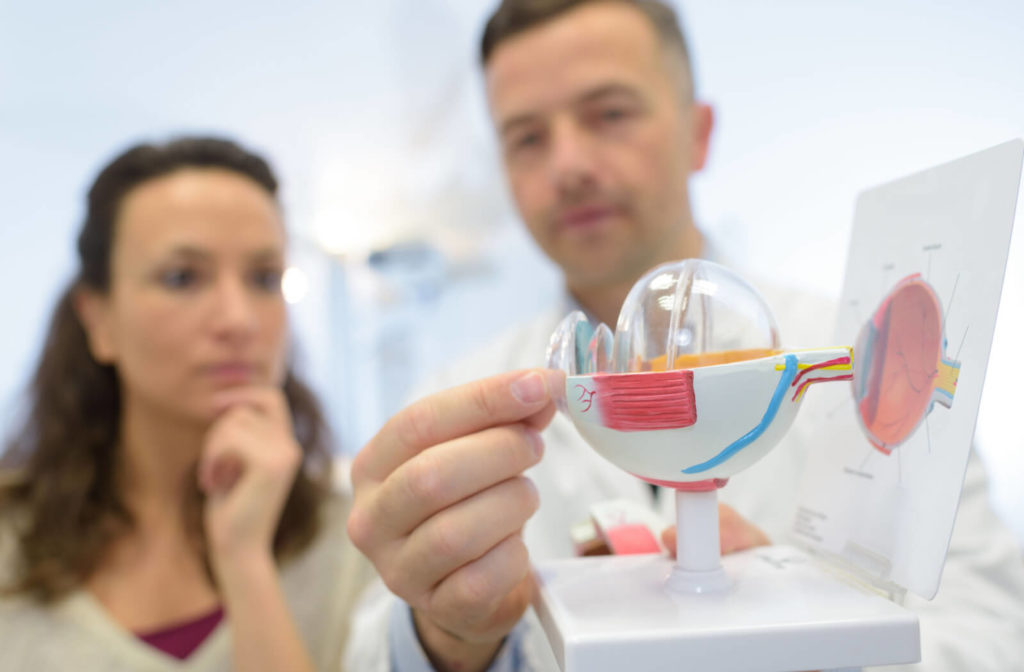Myopia, hyperopia, and astigmatism are refractive errors that make it hard to see clearly, making near and distant vision blurry.
Your eye doctor can diagnose a vision problem with a comprehensive eye exam and recommend several treatment options, such as glasses and contact lenses for correction or surgery to fix the refractive error.
What Is Myopia, Hyperopia, & Astigmatism?
For clear vision, light needs to refract or bend as it passes through the cornea (the transparent front part of the eye) and lens (the clear structure that sits behind the coloured part of the eye). However, variations in eye length, shape of the cornea, or lens can affect how light bends and focuses, resulting in a blurry image.
Myopia
Myopia, or nearsightedness, is when distant objects look blurry, while things nearby are as clear as day.
Myopia results from an eye that’s too long or a cornea that’s too steep, which causes light to focus in front of the retina (the light-sensitive tissue at the back of the eye) instead of directly on it.
Symptoms of myopia include:
- Trouble seeing things that are far away
- Squinting to see clearly
- Eye strain from tired or sore eyes
- Headaches from eye strain
Hyperopia
Hyperopia, or farsightedness, causes nearby objects to appear blurry while things at a distance are clear. It can make near tasks such as reading, writing, or computer usage more challenging.
Hyperopia results from an eye that’s too short or a cornea that’s too flat, which causes light to focus behind the retina instead of on it. You can be born with hyperopia but only experience vision problems later in life. Symptoms of hyperopia can include:
- Trouble seeing things up close
- Eye strain from tired or sore eyes
- Headaches
Astigmatism
Astigmatism is like looking at the world through a funhouse mirror, where both near and distant objects appear distorted or blurred. Unlike myopia and hyperopia, astigmatism is often due to an irregularly shaped cornea or lens, causing light to bend differently as it enters the eyes and is focused on more than one point.
You can be born with astigmatism or develop it as a child or young adult. An eye injury or eye surgery can also result in astigmatism. Astigmatism symptoms include:
- Blurry vision at all distances
- Squinting to see clearly
- Headaches
- Eye strain
- Trouble seeing at night
Risk Factors for Developing a Refractive Error
Anyone can get a refractive error. However, your risk is higher if one or both parents also have a refractive error or wear glasses or contact lenses. Myopia in children can also result from more time doing close-up tasks and less time spent outdoors. For these reasons, it’s vital to have regular adult and children’s eye exams to evaluate and monitor vision and eye health.
Treatment for Myopia
Myopia is easily corrected with glasses or contact lenses. Refractive eye surgery is a more permanent correction for myopia that reshapes the cornea. It can decrease your need for wearing corrective lenses.
Myopia typically starts in early childhood and progresses until the early 20s. Without a timely diagnosis and treatment, it can lead to high myopia or severe nearsightedness.
Because children are unaware of what normal vision is, they may not express any concerns with their eyesight. Instead, watch for some signs that your child may have a vision issue, like if they:
- Are unable to see the white or blackboard at school.
- Hold books too close to the face.
- Sit too close to the TV to see better.
- Frequently rub their eyes.
- Blink a lot or squint.
- Are unaware of objects or people in the distance.
To prevent myopia progression, your eye doctor can recommend myopia control measures, such as:
- Multifocal contacts that contain multiple prescriptions to correct myopia and reduce eye strain.
- Myopia-slowing eyeglasses, such as MiyoSmart lenses.
- Atropine therapy to slow myopia progression.
- MYAH machine, an in-office service that monitors risk and compares axial length measurements of the eye responsible for myopia progression.
Treatment for Hyperopia
Hyperopia is corrected with prescription eyeglasses or contact lenses, which can be multifocal or monovision. Laser eye surgery is also an option for mild to moderate hyperopia.
Treatment for Astigmatism
There is no need for corrective lenses for mild astigmatism that doesn’t affect your vision. If your vision worsens over time, your eye doctor may recommend corrective eyeglasses or contact lenses. Refractive eye surgery changes the shape of the cornea to reduce astigmatism and improve your near and distant vision.
Clear Vision for the Whole Family
Whether you have myopia, hyperopia, or astigmatism, we have a solution for you. For all vision concerns, book an appointment with Queensway Optometric Centre for a treatment plan aligned with your unique visual needs.


